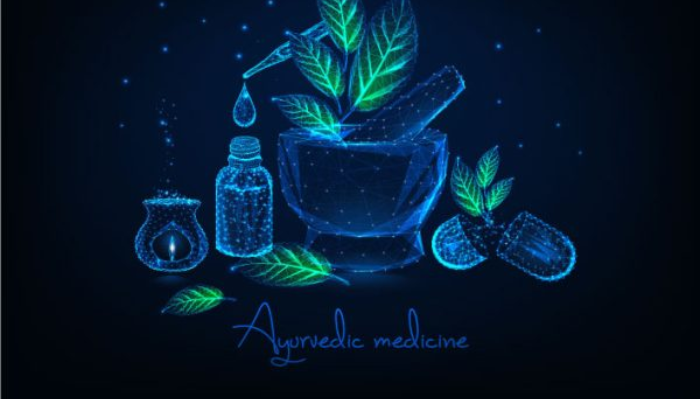
Let’s break it down, for the skeptics, and non-believers and debunk the myths surrounding Ayurveda.
Myth 1– Ayurveda is nothing more than a fun tool in finding and eating according to one’s body type or dosha but cannot help manage any health condition especially any chronic health problem.
That is not true.
Ayurveda can be used in –
a) Prevention – where diet and lifestyle is tailored to one’s doshas so that the doshas remain balanced which in turn helps avoid health problems.
b) Intervention – where herbs, therapies are used – either to pacify doshas (shamana) or to eliminate them (shodhana) as is done in Panchkarma.
Myth 2– The success stories of Ayurveda are often dismissed as mere flukes of luck, with the argument that there is insufficient research to support them.
Again not true.
The gold standard of randomized case control trials (RCT) cannot be applied in the same manner as Ayurveda works on individualized protocols. There are a lot of research articles on pubmed where RCTs are done with 1 group given individualized Ayurvedic protocols and the second group is given comparable conventional medicine. Then there are numerous research papers on the efficacies of various Ayruevdic herbs, therapies in individual cases for various diseases.
Myth 3 – Ayruvedic herbs have no side effects so anyone can take them like vitamins.
Not true.
The herbs are extremely potent and specific to the health problem, specific to the dosha imbalance and specific to the imbalance in a particular tissue or organ so they cannot be used as vitamins. There are a lot of factors to consider before the herbs are recommended. If used incorrectly or for a longer period of time than recommended, they can cause more imbalance leading to more health problems. So do not self medicate. The herbs have to be taken under the guidance of Ayurvedic doctor. The herbs need to be adjusted every 4–5 weeks in the 3 phases.
Myth 4– Ayurveda is ineffective if no results are seen in the first week even if it’s for a chronic problem of many years.
The problem is people do not give Ayurvedic protocols enough time to work, abandoning the protocol within the first week. Yet, they frequently switch doctors and medications in conventional medicine without hesitation. They may switch from one steroid to another or from one antibiotic to another stronger one. In Ayurveda, the first two weeks are crucial when protocols may need to be tweaked especially if people are not following the recommended diet and lifestyle which in today’s day and age has become a challenge. People have high pressure jobs, demanding schools, and colleges.
Ayurveda is keeping up with the times and trying to accommodate the demanding lifestyle by working with the client the first few weeks to get the right protocol for their needs – given their work pressures. Although the ideal recommendation in the protocol is to follow the Ayruevdic circadian rhythm (ACR) to get the best results.
Myth 5 – Let’s address the elephant in the room: the presence of heavy metals!
Let’s get educated on the heavy metals usage in Ayurveda. There are three types of Ayurvedic medicines: plant-based, herbal-metallic, and pure metals. Ayurveda does not deny the usage of heavy metals. These metals undergo purification processes ranging from 10 to 100 times using different herbal decoctions to remove toxicity until they become safe and become nanoparticles.
These bhasmas or nanomedicines can reach their target in milliseconds and are used in micro quantities. There are research papers on the benefits, efficacy, purity and the safety of these bhasmas. If they were as toxic as they have been portrayed, then in India, where these bhasmas are widely used, there would have been an explosion of side effects of heavy metals in the population.
The problem arises when people self-medicate or do not listen to the Ayurvedic Doctor. The bhasmas and herbometals are comparable to steroids, antibiotics or the modern targeted medicines. The way you cannot self medicate or change the dosage of these conventional medicines, you cannot do the same with the herbs and especially bhasmas. The dosage is very specific and should not be exceeded beyond a certain duration. They are more potent than plant-based herbs, so precautions are even more important when using them.
In conclusion, educating oneself about Ayurveda is imperative before passing judgment.
Simmi Chopra is a highly accomplished Ayurvedic Practitioner with a unique blend of expertise in traditional Ayurveda and modern science. Trained in the ancient healing system, she completed the prestigious Ayurveda Doctor program from Kerala Ayurveda. Based in New York City, Simmi practices at SIDH Ayur, where she offers personalized Ayurvedic therapies, dietary guidance, lifestyle recommendations, and herbal solutions to help clients achieve holistic balance. Check out her YouTube link – https://www.youtube.com/watch?v=WlwFnUJOVQs&t=41s
Source : https://www.seema.com/the-ignorance-paradox-dismissing-ayurveda-as-pseudoscience/